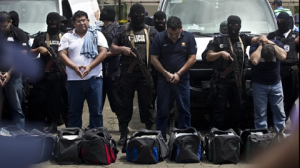Mexican drug cartels are reportedly arming gangs in Costa Rica with high-caliber weaponry, perhaps an indication that the Mexican criminals are shifting operations from countries under intense security pressure to those with weaker drug interdiction and law enforcement capabilities.
On November 13, Costa Rica’s Attorney General Jorge Chavarria announced Mexican drug cartels are giving criminal groups within the country AK-47s and grenades in order to destroy rival drug gangs, reported La Nacion. The Costa Rican gangs are involved in aerial, overland, and maritime drug-smuggling operations, reported El Universal.
Chavarria did not specify which Mexican criminal groups are arming local gangs. However, according to La Nacion the Sinaloa Cartel has had a presence in Costa Rica since 2006, and the Knights Templar is also reportedly active in the country.
The statement comes less than one week after Costa Rica’s Public Security Minister Celso Gamboa announced the country has seized nearly 23 tons of cocaine so far this year, more than any other country in Central America.
Costa Rica’s Public Security Minister told El Universal the presence of Mexican cartels in Costa Rica is “undeniable”.
InSight Crime Analysis
The reported arming of local gangs by Mexican drug cartels signals the on-going evolution of drug transit points in Central America. It is consistent with the strategy of Mexican organized crime groups to establish operations in countries unprepared to combat transnational drug trafficking.
For years, Mexican drug trafficking organizations (DTOs) have used the “Northern Triangle” region (Guatemala, El Salvador, Honduras) as transshipment points for Colombian cocaine being trafficked through Central America before reaching Mexico and the United States. In response to rising levels of crime and violence in these countries, some governments have adopted an iron fist (“mano dura”) security strategy, putting greater pressure on both local street gangs and foreign DTOs. As a result, criminal groups in some countries traditionally unaffected by the transnational drug trade — such as Costa Rica, which has no standing army — have been “colonized” by Mexican drug trafficking groups.
SEE ALSO: Coverage of Criminal Migration
The infiltration of Mexican cartels into Costa Rica is not a new phenomenon. While Colombian drug trafficking groups historically controlled the trafficking routes through Costa Rica, since as early as 2011 regional security experts have documented the increased presence of Mexican DTOs in the country. Costa Rica took steps under current President Laura Chinchilla to combat organized crime by investing in several law-enforcement agencies designed to fight DTOs and signing a bi-lateral maritime surveillance agreement with the United States. However, the recent remarks by the country’s Public Security Minister stating Costa Rica has seized more cocaine than any other Central American nation in 2014 — highlighted by a 2 ton haul in July — suggest government efforts to limit the presence of foreign drug trafficking groups remain inadequate.

